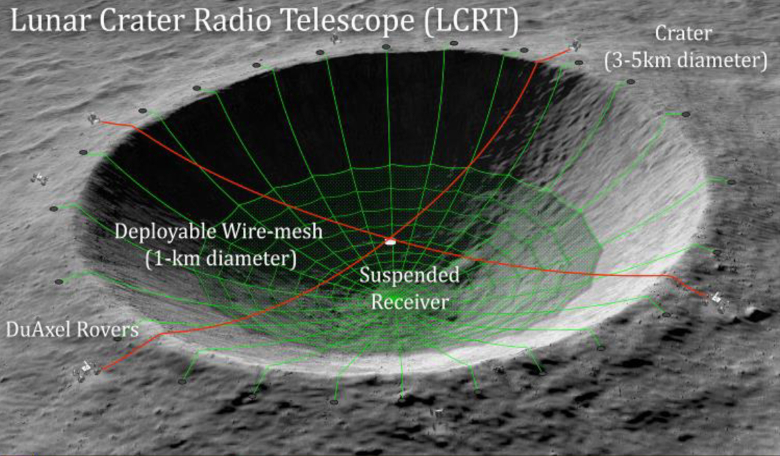NASA’s incubator programme which funds the development of far reaching, long term advanced concepts that “think outside the box,” has awarded a grant for research into turning a huge crater on the far side of the Moon into a giant radio telescope.
NASA’s Institute for Advanced Concepts (NIAC) is a platform that each year nurtures visionary ideas that have the potential to create breakthrough technologies for possible future space missions, by funding projects still in the early stages of development.
For 2020, the US space agency has selected 23 potentially revolutionary concepts with a total award value of $7 million; recipients of Phase I awards receive $125,000 to advance their concept over a nine-month period.
One of the new successful applicants is Saptarshi Bandyopadhyay, a robotics technologist at NASA’s Jet Propulsion Laboratory in California. Bandyopadhyay’s idea is to turn a suitable existing lunar crater, one to 50 kilometres in diameter, on the far-side of the Moon into a spherical reflecting dish and use it as a radio telescope.
Called the Lunar Crater Radio Telescope (LCRT), the dish would be able to observe the Universe in the 5 –100 metre wavelength band, a region of the electromagnetic spectrum rarely utilised in astronomy.
The radio telescope, which would have “tremendous advantages compared to Earth-based telescopes,” according to Bandyopadhyay’s description of his radical concept, could “potentially make tremendous scientific discoveries in fields of cosmology and extrasolar planets.”
An added advantage is that as it will be tucked away out of sight from Earth, the Moon will act as a physical shield that isolates the telescope from the radio interference and noises coming from our planet.
To create the LCRT, Bandyopadhyay suggests using wallclimbing DuAxel robots to drape a deployable wire-mesh one kilometre in diameter on the inside of a large lunar crater.
This would require only a few robots from Earth thereby significantly reducing launch weight and cost compared to all previous lunar-surface telescope mission concepts, says Bandyopadhyay.
If the concept ever came to fruition, then the LCRT would be the largest filled-aperture radio telescope in the Solar System.
Furthermore, the concept idea specifies that the robots could then go onto create a network of LCRTs that would facilitate in lunar Very-Long-Baseline Interferometry (VLBI) astronomy.
VLBI is already a technique used on Earth to perform very high angular resolution observations of cosmic radio sources. It works by linking together antennas that are spread thousands of kilometres apart around the globe.
When connected, they act as a virtual planet-size dish, giving astronomers exceptional resolving power; for example VBLI observations were used by the Event Horizon Telescope last year to make the first ever photograph of a black hole.
A feat that the LCRT's creator is hoping to emulate. “We envisage that this concept would unlock the potential for ground-breaking scientific discoveries in radio astronomy,” concludes Bandyopadhyay.
In addition to Bandyopadhyay’s concept, NASA also awarded a Phase III grant to Slava Turyshev, a researcher at NASA’s Jet Propulsion Laboratory in Pasadena, California, to continue his design for imaging Earth-like planets outside of the solar system.
Turyshev will receive a $2 million grant to further mature the concept and related technologies of his solar gravity lens; a probe located 80.4 billion kilometres (50 billion miles) from Earth that uses multiple small spacecraft and solar sail technology to propel the lens to its target destination.
Turyshev’s idea is only the third study selected for Phase III funding in the history of the program said NIAC Program Executive Jason Derleth.
“We’re excited by its potential to bring us closer to imaging an exoplanet in detail, at a resolution comparable to the well-known Apollo 8 Earthrise photo,” Derleth said.
For a full list of NIAC 2020 Phase I, Phase II and Phase III Selections, click here (opens in new window); https://www.nasa.gov/directorates/spacetech/niac/2...











